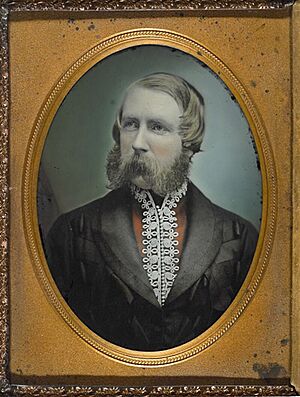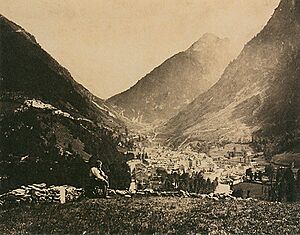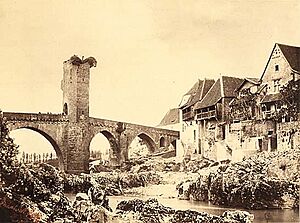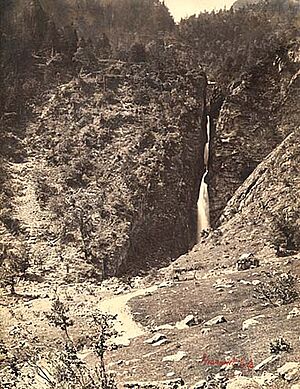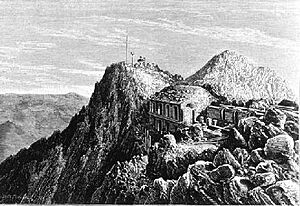Farnham Maxwell-Lyte facts for kids
Farnham Maxwell-Lyte (born January 10, 1828 – died March 4, 1906) was a clever English chemist. He was also a pioneer in photography, meaning he helped invent many ways to develop photos. As a photographer, he was famous for his beautiful pictures of the French Pyrenees mountains.
Contents
Early Life and Discovering Photography
Farnham Maxwell-Lyte was born in Brixham, England, in 1828. He was the youngest of five children. His father, Henry Francis Lyte, wrote the famous song "Abide with Me." In 1851, Farnham married Eleanora Julia Bolton, and they had five children. When Farnham was 16, he first heard about photography. This was around the time William Henry Fox Talbot invented the "calotype," an early photographic process. In 1846, Farnham went to Christ's College at Cambridge University. He studied chemical engineering and graduated in 1851. After college, he worked as a mining engineer. He was also a member of important science groups like the Chemical Society.
Photography Adventures
In 1853, Farnham traveled to Luz-Saint-Sauveur in the Pyrenees mountains because he wasn't feeling well. His family joined him there in 1856. He settled in a town called Pau. In Pau, he met other English photographers. They formed a group known as the "Group of Pau." This group included famous photographers like John Stewart and Louis Désiré Blanquart-Evrard. Farnham lived in France from 1853 until 1880. In 1854, he helped start the Société française de photographie (French Photographic Society). He was also an honorary member of the Royal Photographic Society.
Improving Photo Processing
Since Farnham was both a chemist and a photographer, he made many improvements to how photos were developed. He worked with different materials like collodion and wax paper. He even invented his own process called métagélatine. This method helped photographers make better pictures. It was so good that it was described in a photography book called Cyclopedic Photography. In 1854, he shared his findings on what became known as the "honey" process. This was a way to keep photographic plates ready to use for longer. As the name suggests, he used honey in this process! He published his experiments in a magazine called Notes and Queries.
Farnham was also one of the first to add a separate sky into a landscape photo. This helped solve problems with how early photographic plates captured light. He explained this idea in a letter to a photography journal in 1861. In 1862, he wrote about chemicals in photographic paper that could harm silver prints. He also introduced special toning baths using borax and phosphate, which are still used today. He was also a pioneer in using iodide in photography.
Capturing Landscapes
Maxwell-Lyte took many scenic photographs before commercial photographers started selling mass-produced views in the 1860s. He was a wealthy amateur photographer, meaning he took photos for fun, not mainly to sell them. He photographed the mountains, villages, waterfalls, and bridges of the Pyrenees. He often showed his photos through the Société française de photographie. He exhibited his work almost every year from 1855 to 1865 in cities like London, Glasgow, Edinburgh, and Paris. He won several international awards. He earned a silver medal at the 1855 World's Fair in Paris. His Pyrenean landscapes also won a gold medal in Bordeaux in 1859.
He regularly sent his photos to the Photographic Society of Scotland's yearly exhibition in Edinburgh. He won silver medals for his photos "Pierrefith" and "Lac d'Oo." Even when some of his beautiful photos were damaged during shipping, they were skillfully repaired for the exhibition. Some of his photographs were included in a book of Pyrenean views in 1858.
Société Ramond
In 1864, Maxwell-Lyte helped start the Société Ramond. This was a scientific group dedicated to studying the Pyrenees mountains, including their culture and nature. He was chosen as the society's first vice-president. The Société Ramond was important because it led to the building of the observatory on the Pic du Midi de Bigorre mountain. Before the observatory was built, Maxwell-Lyte used a large telescope to make observations. He even took photos of a solar eclipse on July 18, 1860. He also recorded weather information, like the average temperature in Bagnères-de-Bigorre for two years.
Later Years
Maxwell-Lyte stopped photography when he moved with his family to Dax, France. He went back to his first job as a mining engineer. He bought some sulfur springs and a salt mine, but these businesses were not successful. He passed away suddenly in 1906 in London. He was buried at St Mary The Boltons in Kensington. The British Journal of Photography remembered his death in 1906. They praised his contributions to photography, especially his "honey" process. They also noted his work on preventing damage to photos and his invention of borax and phosphate toning baths.


